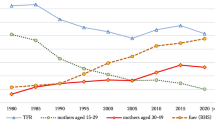Abstract
In this paper, I examine the implications of the Rawlsian maximin criterion for optimal population size and intergenerational allocation of resource when fertility is endogenous. I show that whenever children are better-off than their parents in laissez-faire, then the size of the population and parental bequests are also optimal according to the Rawlsian criterion. Otherwise, laissez-faire leads to overpopulation and suboptimal bequests. I then show that by using proper price-based corrective policies, society can achieve a Rawlsian optimal allocation. These policies involve either a combination of a subsidy to aggregate future consumption and a per-capita tax on children, or a subsidy to average future consumption.
Similar content being viewed by others
References
Arrow K (1973a) Rawls's principle of just savings. Swed J Econ 75:323–335
Arrow K (1973b) Some ordinalist-utilitarian notes on Rawls's theory of justice. J Philos 70:245–263
Atkinson A, Stiglitz J (1980) Lectures on public economics. McGraw-Hill, New York
Cooter R, Helpman E (1974) Optimal income taxation for transfer payments under different social welfare criteria. Q J Econ 88:656–670
Dasgupta P (1974) On some alternative criteria for justice between generation. J Public Econ 3:405–423
Dasgupta P (1987) The ethical foundations of population policy. In: Johnson D, Lee R (eds) Population growth and economic development: issues and evidence. The University of Wisconsin Press, Madison, pp 631–659
King E (1987) The effect of family size on family welfare: what do we know? In: Johnson D, Lee R (eds) Population growth and economic development: issues and evidence. The University of Wisconsin Press, Madison, pp 373–411
Klevorick A (1974) Distributional equity — discussion. Am Econ Rev 64:158–161
Narveson J (1978) Future people and us. In: Sikora RI, Barry B (eds) Obligations to future generations. Temple University Press, Philadelphia, pp 38–60
Nerlove M, Razin A, Sadka E (1987) Household and economy, welfare economics of endogenous fertility. Academic Press, New York
Parfit D (1984) Reasons and persons. Oxford University Press, Oxford
Phelps E (1973) Taxation of wage income for economic justice. Q J Econ 87:331–354
Rawls J (1971) A theory of justice. Harvard University Press, Cambridge, MA
Warren M (1978) Do potential people have moral rights?In: Sikora RI, Barry B (eds) Obligations to future generations. Temple University Press, Philadelphia, pp 14–30
Author information
Authors and Affiliations
Additional information
For their comments, I thank two anonymous referees. I also thank Assaf Razin and Efraim Sadka for their comments on an earlier draft.
Rights and permissions
About this article
Cite this article
Spiegel, Y. Rawlsian optimal population size. J Popul Econ 6, 363–373 (1993). https://doi.org/10.1007/BF00599044
Received:
Accepted:
Issue Date:
DOI: https://doi.org/10.1007/BF00599044




